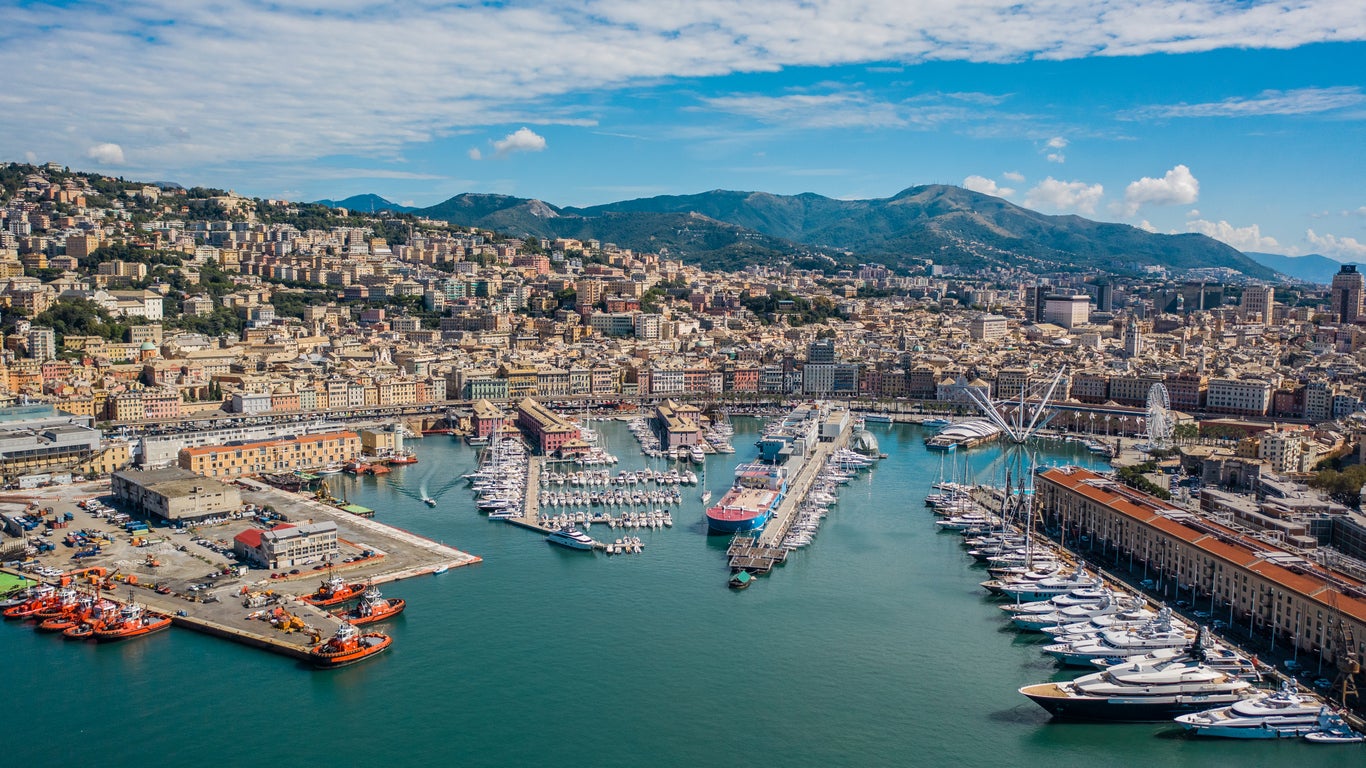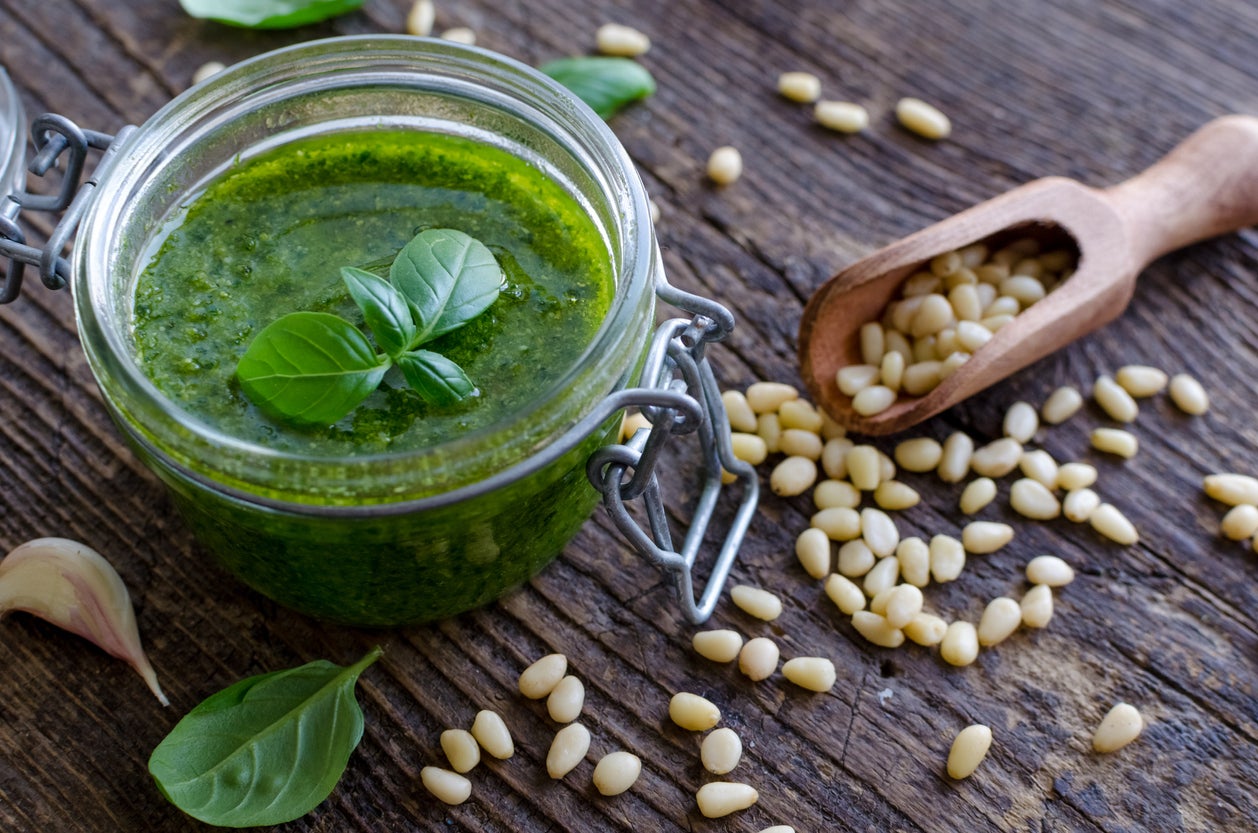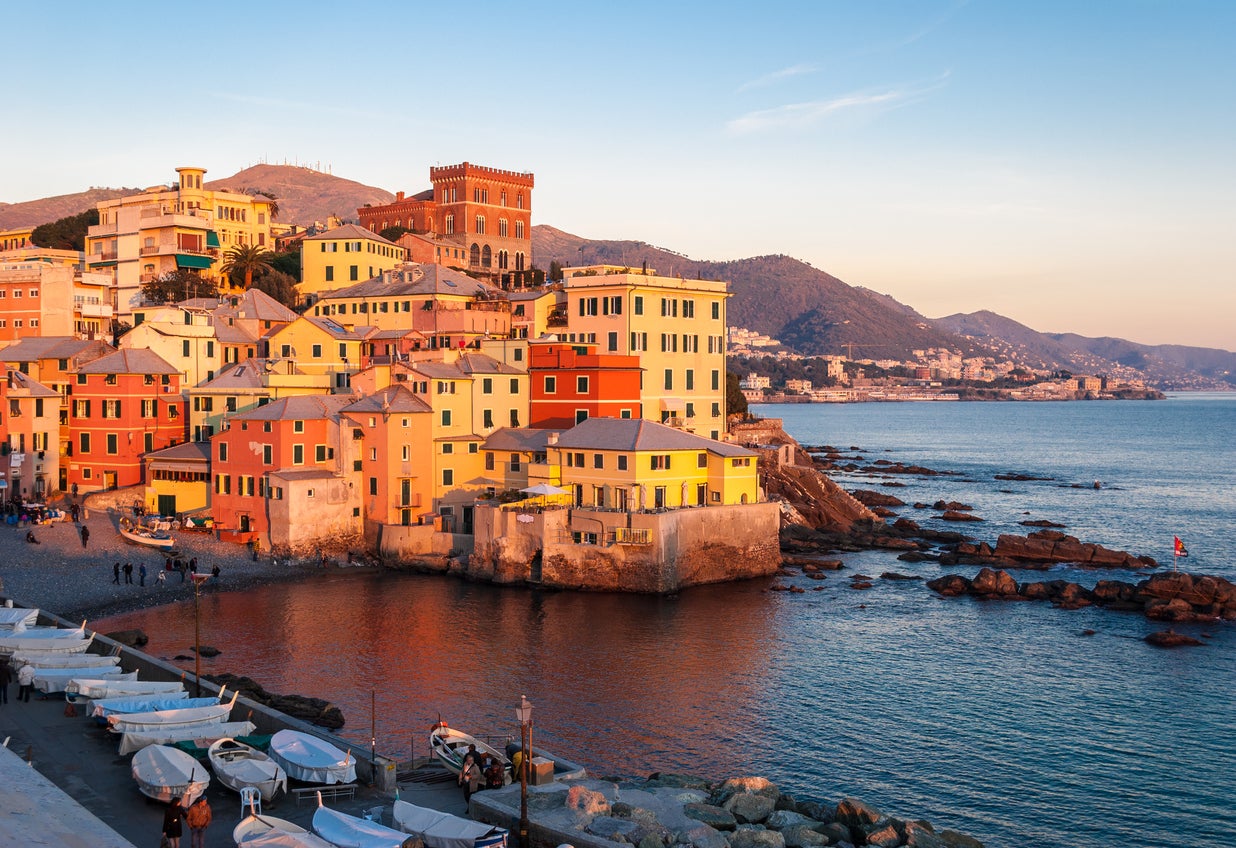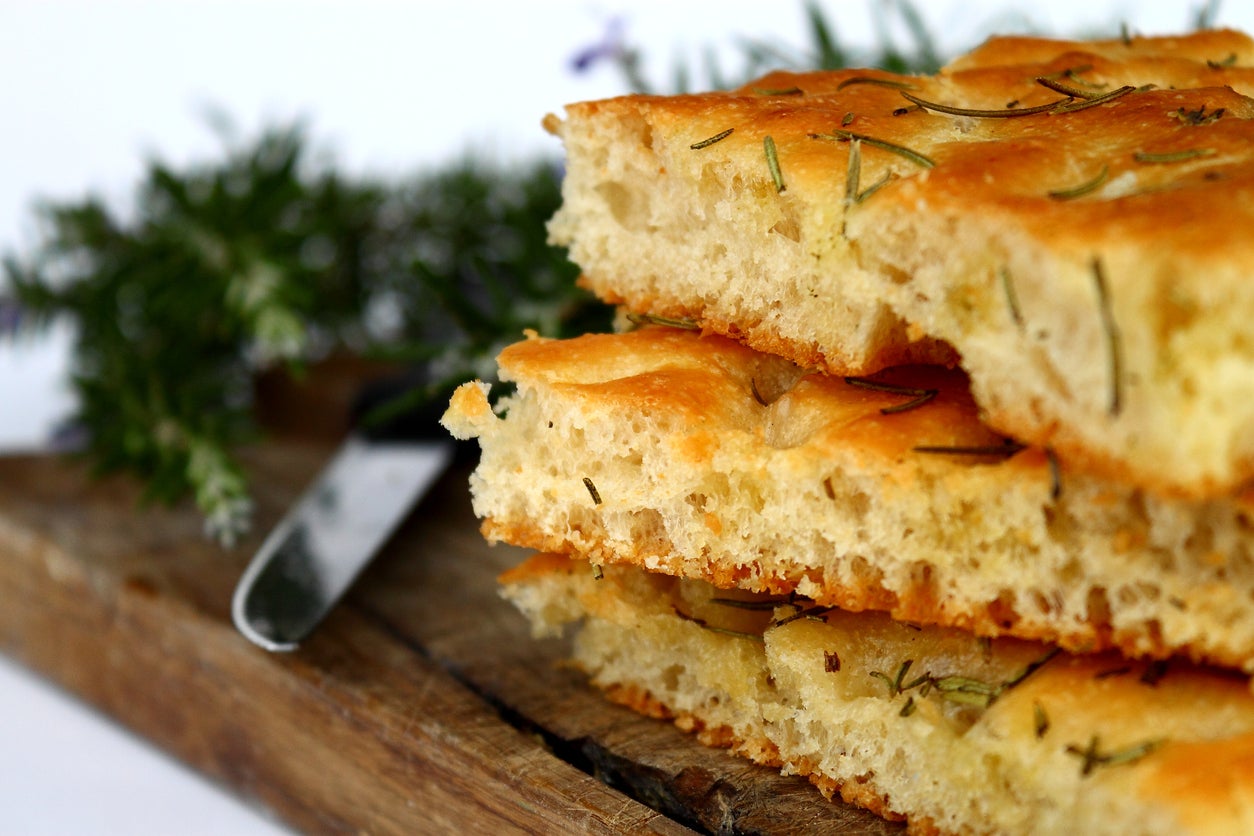Genoa city guide: Where to stay, eat, drink and shop in this affordable Italian charmer
This low-key, low-priced port city is the home of simple, salt-of-the-earth pleasures such as pesto and focaccia, says Kash Bhattacharya. Why wouldn’t you dig in?

Your support helps us to tell the story
From reproductive rights to climate change to Big Tech, The Independent is on the ground when the story is developing. Whether it's investigating the financials of Elon Musk's pro-Trump PAC or producing our latest documentary, 'The A Word', which shines a light on the American women fighting for reproductive rights, we know how important it is to parse out the facts from the messaging.
At such a critical moment in US history, we need reporters on the ground. Your donation allows us to keep sending journalists to speak to both sides of the story.
The Independent is trusted by Americans across the entire political spectrum. And unlike many other quality news outlets, we choose not to lock Americans out of our reporting and analysis with paywalls. We believe quality journalism should be available to everyone, paid for by those who can afford it.
Your support makes all the difference.The home of pesto and Christopher Columbus, Genoa is often bypassed in favour of Instagram-magnet Cinque Terre or fashionista’s-choice Milan. Which is a shame, because to neglect this handsome port is to miss out on one of Italy’s most affordable, low-key, local-vibes cities.
Genoa’s main appeal is that it feels 100 per cent Genovese, rather than overrun with fellow tourists. Once you get lost in its hypnotic maze of narrow caruggi alleyways, you’ll spot glorious Renaissance palaces alongside the angular modern creations of Genoa’s second most celebrated son, Renzo Piano; and from farinata to focaccia, you’ll get to try some of Italy’s best street food. Ugly yet beautiful, like all fantastically atmospheric port cities, it’s a city whose gnarled beauty grows on you.
What to do
Walk the historical centre
Nothing quite prepares you for the dark labyrinth of narrow streets that criss-cross the old town of Genoa – a neighbourhood that Henry James called “the most entangled topographical ravel in the world”. It is dense, but ducking down these caruggi is the best way to get into the rhythm of this port city, dodging scooters, catching a waft of freshly-ground pesto from a trattoria, or soaking in the smell of spices from the Bangladeshi grocery stores. Start at the 12th-century city gates, Porta Soprana, east of Centro Storico, believed to be the birthplace of Christopher Columbus. Then snake your way to the main square, Piazza de Ferrari, with its grand bronze fountain.
Your next stop is the Cathedral of San Lorenzo, with its ornate grey and white marble facade, reminiscent of Florence’s Duomo. Inside, you’ll find the alleged remains of John the Baptist and also an unexploded Second World World War bomb from 1941. To finish off, for the price of a single ticket ( €1.50) hop on one of the city’s historic funiculars to get a fantastic panoramic view of the city’s harbour and skyline.
Peek at grand palazzos
Get an idea of the scale of Genoa’s maritime influence and historic wealth by taking a stroll along the Strade Nuove (new streets), where the city’s richest merchants, bankers and ship owners built a strip of ornate palaces – 42 to be precise. These are now designated Unesco world heritage sites. If you only have time to visit one, make it Palazzo Ducale, the former residence of the Doges. Today, it is the most important cultural and events venue in town. Rotating exhibitions inside give visitors a chance to glimpse the splendid interiors – on now is a show on graphic artist MC Escher, running to February 2022. If you’ve time for two, head for the 13th-century Grimaldina Palace, for the sweeping view from its tower.
Seaside sightseeing
A fantastic tribute to Genoa’s close relationship with the sea, the city aquarium (€27 for adults, €23 reduced, €19 for kids aged 4-12.) is the biggest in Europe and an undoubted highlight of visiting the city. Attracting more than half a million visitors a year, the aquarium’s staggering 70 tanks recreate the marine and terrestrial habitat of more than 6,000 animals belonging to 600 species. If you want to know more about Genoa’s seafaring history, pop next door to the Galata Museo Del Mare (adults €17, child €12) where you’ll find a variety of hands-on high-tech exhibits. You’ll learn everything there is to know about Genoa’s favourite explorer, Columbus, and get to check out the inside of the S518 Nazario Sauro submarine.

Where to eat
Don’t stick to the standard pizzas and pastas – there are countless local Genovese dishes that visitors overlook. In the home of the nutty, basil-packed purée, Pesto Genovese is a must, served with a short, twisted pasta called trofie. A good place to try this is its namesake trattoria: Sa Pesta, located in Genoa’s old city district.
Another typical Genovese delicacy you have to sample in Genoa is focaccia, freshly baked bread typically rolled out or pressed by hand into a thick layer of dough and then baked in a stone-bottomed oven. Foccacia is everything to the Genovese: they dip it in their cappuccino, snack it at work or enjoy with a glass of wine during aperitivo hour. You can sample it at a bakery, bar or sciamadda. My tip is Pasticceria Priano, to the west of the city – their focaccia is wafer-thin and crispy, sprinkled with maize flour for extra flavour.
At Antica Sciamadda (14 Via S. Giorgio, +39 010 246 8516 ) savour another Genovese speciality, farinata di ceci. Thin and perfectly baked in their wood fired oven, this chickpea pancake just melts in your mouth. Your last stop is the hole in the wall Antica Friggitoria Carega ( 113 Via di Sottoripa, +39 010 247 0617 ) by the Porto Antico, for friggitoria – a pick-and-mix of fried seafood snacks including fried calamari, octopus, shrimps and anchovies.
Where to drink
Kick off your evening in style with a local favourite asinello, better known as corochinato – a fortified wine from Genoa, flavoured with an intriguing mix of 16 herbs and spices including two types of absinthe, cinchona bark and rhubarb. The place to sip it is Bar Degli Asinelli (78 Via di Canneto Il Lungo, +39 010 246 8703) where it is served chilled, with a slice of lemon (€1.50) and a generous basket of focaccia.
One evening should be dedicated to the classic northern Italian tradition of aperitivo – at around 5-7pm, locals take to the wine bars for a wine or beer, and get a generous portion of free finger food thrown in – think a mini-buffet of cheeses, salami and focaccia served with your drink. Bar Delle Vigne (4 Vico dell’Amor Perfetto, +39 010 255828) in the Centro Storico does one of the best spreads.
Another classic local wine bar is Paul Vineria Genova (36 Via di Canneto Il Curto, +39 010 246 8708), where glasses of wine start from a mere €1 a pour. Try their “Chardonnay Frizz”, a slightly fizzy white wine from the Veneto region, served by the lovely, warm owners.
Before sunset, pop over to the pastel-painted fishing village of Boccadasse, on the outskirts of Genoa. La Strambata (5 Piazza Nettuno, +39 010 869 7002 ) does a great aperitivo on a terrace facing the village’s pebble beach, trimmed by moored fishing boats. Afterwards, Antica Gelateria Amedeo is the place to go for a gelato or frozen yoghurt.

Where to shop
Time stands still in the medieval heart of Genoa, the largest in Europe, where you walk back in time at places such as Italy’s oldest artisan confectioner, Antica Confetteria Pietro Romanengo. Making sweets since 1780, they use traditional Genoese recipes that originated from the Far East to satisfy the locals’ sweet tooth – try the candied fruit, bonbons and preserves. For delicious pastries and the best cappuccino in town stay in the old quarter and visit Fratelli Klainguti, a bar and pasticceria dating back to 1826, which counts Giuseppe Verdi and Garibaldi as its patrons.
Do visit Via XX Settembre, one of Genoa’s main shopping arteries, where you will find all the international and local brands as well as the city’s best market, MOG Mercato Orientale. Like all good food markets, it’s a proper whirlwind of colour, scents and delicious flavours. Sniff out pungent truffles (white and black) as well as pecorino cheese, fresh fish, handmade pasta and freshly made genovese pesto – great if you’re self catering. There’s also a food court and bar, and cooking classes on offer.
If you’re interesting in design and unique gift ideas, try Temide, a shop that promotes local Ligurian artists. You’ll find everything here from paintings and vintage clothing to handmade jewellery and ceramic sculptures.
Where to stay
A true grand dame of the Belle Epoque era, the Grand Hotel Savoia is decked out with Murano-glass chandeliers, marble floors and lush furnishings – a throwback to the golden age of transatlantic travel. Built in 1897, the hotel exudes history and luxury from every nook and cranny. There’s a rooftop terrace with 360-degree views and an opulent basement spa. Rooms cost from £112 a night. grandhotelsavoiagenova.it
Next door to the Savoia, and in close proximity to the railway station and harbour, the four-star Hotel Continental is housed in a historic 19th century building but enjoys the comfort of modern interiors. The rooms, with gleaming parquet floors, are tastefully decorated to reflect the Genoese style, with nods to the maritime history of the town. The breakfast buffet is fantastic here, replete with warm, flaky croissants, fresh fruit and cheeses. hotelcontinentalgenova.it

Genoa’s newest design hostel, Ostello Bello Genova, is just across the road from the Continental. In keeping with its harbour-adjacent location, it has a quirky maritime theme throughout the building. The highlight is a huge outdoor terrace with a barbecue corner, and plenty of hammocks to sink into with a book. The ground floor bar is open all day and night, where you can eat unlimited free focaccia and save cash by using its self-service communal kitchen. Choose from dorms or private ensuite rooms – a select few privates come with their own outdoor terrace – ask in advance. Prices start from £18 a night for a bed in a dorm or £45 for a double ensuite room. ostellobello.com/hostel/ostello-bello-genova
Nuts and bolts
What currency do they use?
The Euro.
What language do they speak?
Italian. English and French are also commonly heard.
How much should I tip?
Tipping is not essential, but appreciated for exceptional service – aim for 10-15 per cent.
What’s the time difference?
Genoa is one hour ahead of the UK.
How should I get around?
Genoa has an excellent public transportation system including rail lines, buses, water buses, cable cars, public elevators and a short underground line run by AMT.
What’s the best view?
In the Castelletto residential quarter, you’ll find the elevated platform of Spianata Castelletto. The walkway and platform have dazzling views of Genoa’s brick rooftops and the not-too-distant harbour. Spy on the boats and ships, wafting in and out of the harbour, or go at night to see a glimmering blanket of city lights.
Insider tip?
For a day trip, the village of Camogli is beautiful, with a decent beach. It’s easily accessible by local regional train from Genoa (€3.60 one way) – or there are boat services from Genoa to Portofino and Cinque Terre – ask your hotel or hostel reception about booking tickets.
Getting there
Trying to fly less?
You can get from the UK to Genoa entirely by train in around 12 hours: take the Eurostar from London to Paris, then switch to Gare de Lyon for a direct TGV service to Turin’s Torino Porta Susa station. From here, transfer across to Torino Lingotto, and take the local Re train on to Genova Brignole station in Genoa.
Fine with flying?
Ryanair flies direct to Genoa from London Stansted; or it’s a two-hour drive from Milan Linate.
Join our commenting forum
Join thought-provoking conversations, follow other Independent readers and see their replies
0Comments